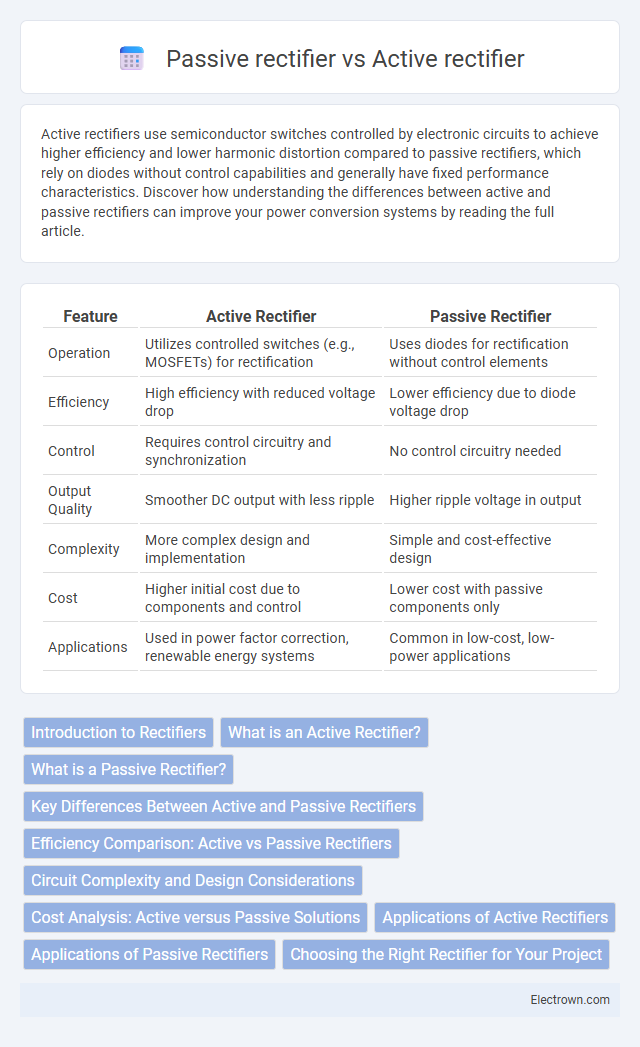Active rectifiers use semiconductor switches controlled by electronic circuits to achieve higher efficiency and lower harmonic distortion compared to passive rectifiers, which rely on diodes without control capabilities and generally have fixed performance characteristics. Discover how understanding the differences between active and passive rectifiers can improve your power conversion systems by reading the full article.
Table of Comparison
| Feature | Active Rectifier | Passive Rectifier |
|---|---|---|
| Operation | Utilizes controlled switches (e.g., MOSFETs) for rectification | Uses diodes for rectification without control elements |
| Efficiency | High efficiency with reduced voltage drop | Lower efficiency due to diode voltage drop |
| Control | Requires control circuitry and synchronization | No control circuitry needed |
| Output Quality | Smoother DC output with less ripple | Higher ripple voltage in output |
| Complexity | More complex design and implementation | Simple and cost-effective design |
| Cost | Higher initial cost due to components and control | Lower cost with passive components only |
| Applications | Used in power factor correction, renewable energy systems | Common in low-cost, low-power applications |
Introduction to Rectifiers
Rectifiers convert alternating current (AC) to direct current (DC) in various electronic applications. Active rectifiers use controlled semiconductor switches like MOSFETs to improve efficiency and reduce voltage drop, while passive rectifiers rely on diodes with fixed conduction characteristics. Your choice impacts power loss, heat generation, and overall system performance in power conversion processes.
What is an Active Rectifier?
An active rectifier uses controlled semiconductor devices like MOSFETs or IGBTs to convert AC to DC with higher efficiency and lower harmonic distortion compared to passive rectifiers. Unlike passive rectifiers, which rely on diodes, active rectifiers optimize power factor correction and reduce energy losses, making them ideal for advanced power electronics applications. Your choice of an active rectifier enhances overall system performance, especially in renewable energy systems and electric vehicle chargers.
What is a Passive Rectifier?
A passive rectifier uses diodes or other passive components to convert AC to DC without external control, relying solely on the inherent properties of these components. Unlike active rectifiers, passive rectifiers cannot regulate output voltage or adapt to varying input conditions, resulting in lower efficiency and higher harmonic distortion. Understanding the limitations of a passive rectifier helps you decide if a more efficient, controllable active rectifier is necessary for your power conversion needs.
Key Differences Between Active and Passive Rectifiers
Active rectifiers use semiconductor switches controlled by external signals to improve efficiency and reduce harmonic distortion, while passive rectifiers rely solely on diodes for unidirectional current flow. Active rectifiers enable bidirectional power flow and can actively regulate output voltage, whereas passive rectifiers are simpler but generate higher losses and less precise control. The key differences include efficiency, controllability, harmonic distortion, and the ability to accommodate regenerative power.
Efficiency Comparison: Active vs Passive Rectifiers
Active rectifiers deliver higher efficiency than passive rectifiers by actively controlling the switching elements, resulting in reduced power losses and improved power factor. Passive rectifiers rely on fixed diodes, causing greater voltage drops and increased heat generation, which leads to lower overall efficiency. Choosing an active rectifier can enhance your system's energy savings and performance, especially in applications demanding precise power management.
Circuit Complexity and Design Considerations
Active rectifiers feature complex circuit designs incorporating semiconductor switches and control circuitry that optimize efficiency and reduce power loss, making them ideal for applications requiring precise voltage regulation. Passive rectifiers use simpler configurations of diodes, resulting in lower design complexity but higher power dissipation and less control over output characteristics. Your choice depends on balancing design sophistication against performance needs and system constraints.
Cost Analysis: Active versus Passive Solutions
Active rectifiers generally incur higher upfront costs due to their complex circuitry and need for control components, while passive rectifiers are more cost-effective because of their simpler design using diodes and minimal electronics. However, active rectifiers offer improved efficiency and reduced power losses, which can lower operating expenses and yield long-term savings in energy consumption. Your choice between active and passive rectifiers should consider both initial investment and potential efficiency gains impacting overall cost-effectiveness.
Applications of Active Rectifiers
Active rectifiers are used in renewable energy systems, electric vehicle chargers, and industrial motor drives to improve power factor and reduce harmonic distortion. They offer efficient energy conversion and precise control, making them ideal for high-performance applications requiring low losses and grid compliance. Your system benefits from enhanced reliability and energy savings with the integration of active rectification technology.
Applications of Passive Rectifiers
Passive rectifiers are widely used in low-cost, low-power applications such as battery chargers, power supply units, and simple AC-to-DC conversion circuits due to their simplicity and reliability. These rectifiers, typically composed of diodes, efficiently convert AC voltage to DC without the need for complex control systems, making them ideal for consumer electronics and household appliances. Passive rectifiers are also common in situations where power quality and efficiency are less critical, such as in LED lighting and small motor drives.
Choosing the Right Rectifier for Your Project
Selecting the right rectifier for your project involves evaluating efficiency, complexity, and cost; active rectifiers offer higher efficiency and reduced power loss through controlled switching but require complex circuitry and higher initial costs. Passive rectifiers, using diodes or thyristors, provide simplicity, reliability, and lower upfront expenses but suffer from higher power dissipation and lower efficiency. Consider the project's power rating, energy efficiency targets, and budget constraints to determine whether an active or passive rectifier best meets your performance and cost requirements.
Active rectifier vs passive rectifier Infographic

 electrown.com
electrown.com